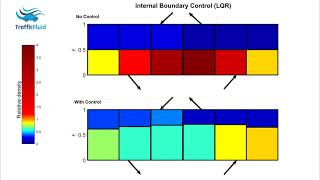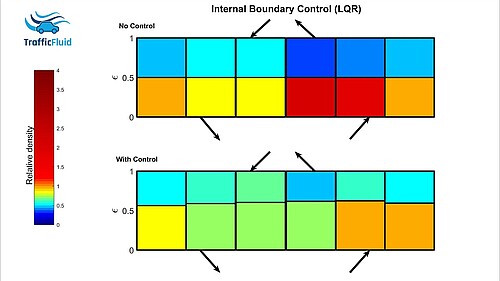Video Playlist 6. Linear-Quadratic Regulators (LQR) for internal boundary control of lane-free automated vehicle traffic
The videos included in this playlist are part of the results discussed in the paper titled "Linear-Quadratic regulators for internal boundary control of lane-free automated vehicle traffic". Lane-free traffic implies that incremental road widening (narrowing) leads to corresponding incremental increase (decrease) of capacity; and this opens the way for consideration of real-time internal boundary control on highways and arterials, in order to flexibly share the total (both directions) road width and capacity among the two directions in dependence of the bi-directional demand and traffic conditions, so as to maximize the total (two directions) flow efficiency. A feedback control scheme is proposed in this work employing an LQR and the corresponding results are presented in the videos.
The videos present a hypothetical highway (two directions) with 6 segments (cells) and indicated on-ramps and off-ramps. The colours in each cell and direction refer to the corresponding values of relative densities, as they evolve for respective external demand scenarios described in the above article. Note that relative-density values higher than 1 indicate congested traffic. The upper figure in each video reflects the no-control (fixed-boundary) case; while the lower figure reflects the internal boundary control case.
Another Playlist presents the same scenarios using model-based open-loop optimal control with perfect external demand prediction. Compared to those videos, it can be seen here that the feedback controller is purely reactive (not proactive) as there is no use of external demand prediction. Therefore the internal boundary is seen to be moved not in anticipation of the imminent demand peak as in open-loop control, but in reaction to the prevailing relative densities. Nevertheless the control quality attained is virtually the same.
The uncongested case
This video displays results of an external demand scenario, for which congestion appearing in the no-control case can be utterly avoided by internal boundary control.

The congested case
This video displays results of an external demand scenario, for which congestion appearing in the no-control case can be strongly mitigated but cannot be utterly avoided by internal boundary control.

